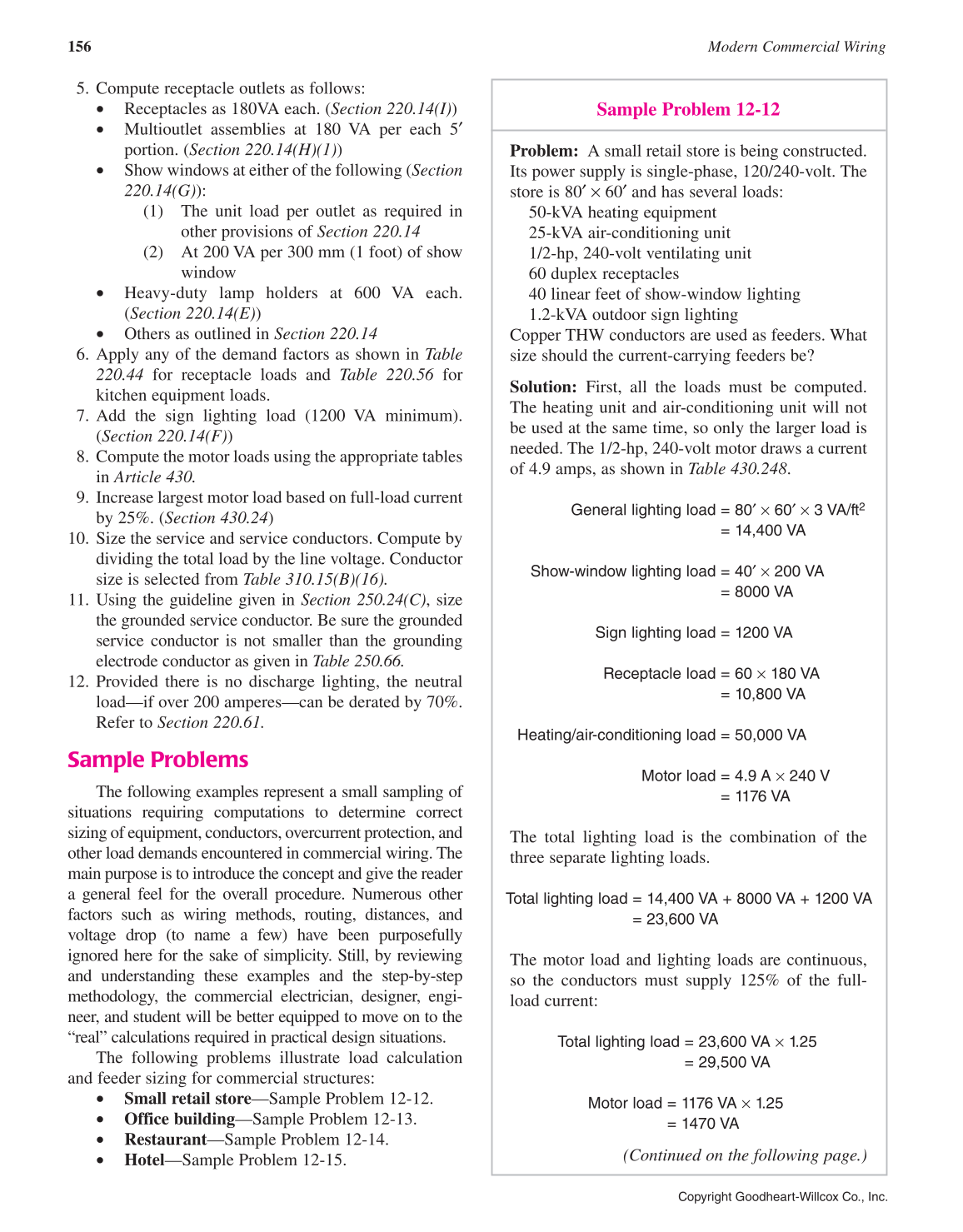156 Modern Commercial Wiring
Copyright Goodheart-Willcox Co., Inc.
5. Compute receptacle outlets as follows:
• Receptacles as 180VA each. (Section 220.14(I))
• Multioutlet assemblies at 180 VA per each 5′
portion. (Section 220.14(H)(1))
• Show windows at either of the following (Section
220.14(G)):
(1) The unit load per outlet as required in
other provisions of Section 220.14
(2) At 200 VA per 300 mm (1 foot) of show
window
• Heavy-duty lamp holders at 600 VA each.
(Section 220.14(E))
• Others as outlined in Section 220.14
6. Apply any of the demand factors as shown in Table
220.44 for receptacle loads and Table 220.56 for
kitchen equipment loads.
7. Add the sign lighting load (1200 VA minimum).
(Section 220.14(F))
8. Compute the motor loads using the appropriate tables
in Article 430.
9. Increase largest motor load based on full-load current
by 25%. (Section 430.24)
10. Size the service and service conductors. Compute by
dividing the total load by the line voltage. Conductor
size is selected from Table 310.15(B)(16).
11. Using the guideline given in Section 250.24(C), size
the grounded service conductor. Be sure the grounded
service conductor is not smaller than the grounding
electrode conductor as given in Table 250.66.
12. Provided there is no discharge lighting, the neutral
load—if over 200 amperes—can be derated by 70%.
Refer to Section 220.61.
Sample Problems
The following examples represent a small sampling of
situations requiring computations to determine correct
sizing of equipment, conductors, overcurrent protection, and
other load demands encountered in commercial wiring. The
main purpose is to introduce the concept and give the reader
a general feel for the overall procedure. Numerous other
factors such as wiring methods, routing, distances, and
voltage drop (to name a few) have been purposefully
ignored here for the sake of simplicity. Still, by reviewing
and understanding these examples and the step-by-step
methodology, the commercial electrician, designer, engi-
neer, and student will be better equipped to move on to the
“real” calculations required in practical design situations.
The following problems illustrate load calculation
and feeder sizing for commercial structures:
• Small retail store—Sample Problem 12-12.
• Office building—Sample Problem 12-13.
• Restaurant—Sample Problem 12-14.
• Hotel—Sample Problem 12-15.
Sample Problem 12-12
Problem: A small retail store is being constructed.
Its power supply is single-phase, 120/240-volt. The
store is 80′ × 60′ and has several loads:
50-kVA heating equipment
25-kVA air-conditioning unit
1/2-hp, 240-volt ventilating unit
60 duplex receptacles
40 linear feet of show-window lighting
1.2-kVA outdoor sign lighting
Copper THW conductors are used as feeders. What
size should the current-carrying feeders be?
Solution: First, all the loads must be computed.
The heating unit and air-conditioning unit will not
be used at the same time, so only the larger load is
needed. The 1/2-hp, 240-volt motor draws a current
of 4.9 amps, as shown in Table 430.248.
General lighting load = 80′ × 60′ × 3 VA/ft2
= 14,400 VA
Show-window lighting load = 40′ × 200 VA
= 8000 VA
Sign lighting load = 1200 VA
Receptacle load = 60 × 180 VA
= 10,800 VA
Heating/air-conditioning load = 50,000 VA
Motor load = 4.9 A × 240 V
= 1176 VA
The total lighting load is the combination of the
three separate lighting loads.
Total lighting load = 14,400 VA + 8000 VA + 1200 VA
= 23,600 VA
The motor load and lighting loads are continuous,
so the conductors must supply 125% of the full-
load current:
Total lighting load = 23,600 VA × 1.25
= 29,500 VA
Motor load = 1176 VA × 1.25
= 1470 VA
(Continued on the following page.)
